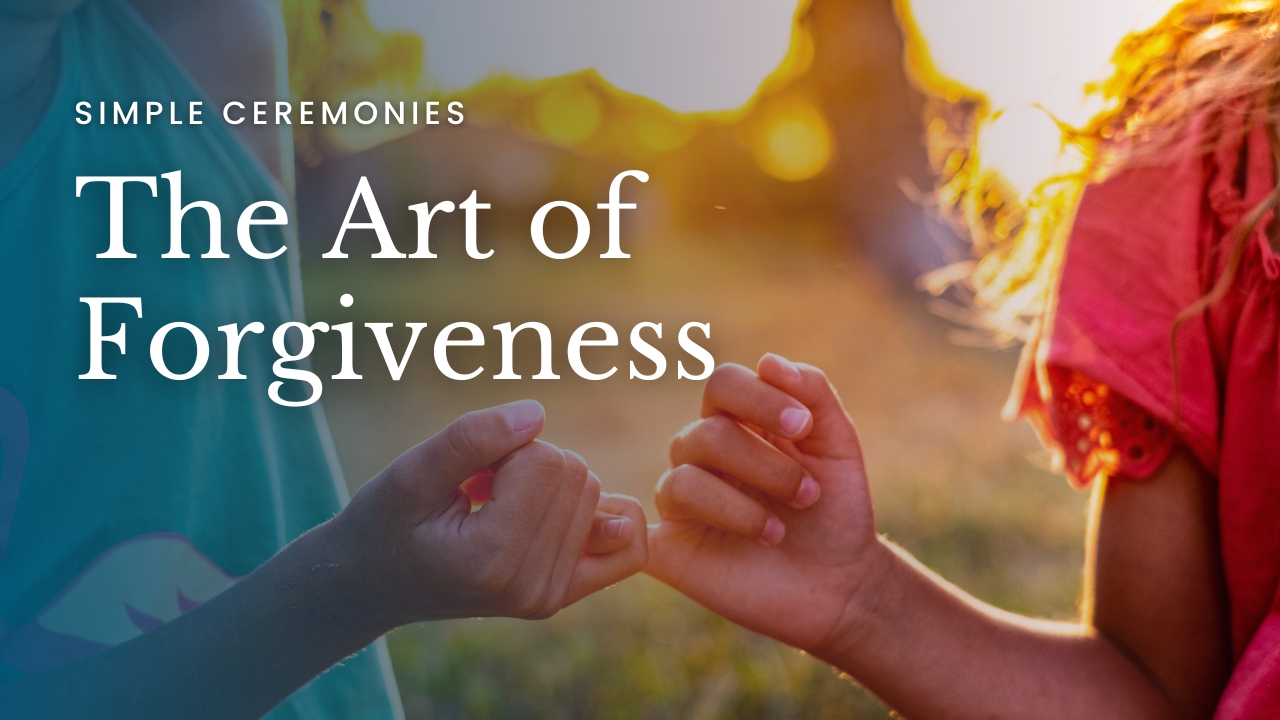Simple Ceremonies: The Art of Forgiveness

As August rolls in, I find myself reflecting on the past few months. My family has experienced a great deal of change and much of it was at the hands of others. If you know me at all, you know I don’t believe in victimhood. We are such powerful creators and allowing ourselves to play the blame game gives power to others rather than empowering us to take full control of our own lives.
That said - - people do mean things. It’s a fact. And even if we do our best to ask, “What am I learning from this experience and how does it benefit me,” we can still find ourselves hurt and angry about the actions of other people and how those actions affect us.
Forgiveness is a powerful act of compassion and healing, both for ourselves and others. Carrying the weight of past grievances can hinder our growth and rob us of inner peace. The art of forgiveness, like any other art form, takes practice and dedication to master. Today, I’d like to offer you a simple ritual to help you master the art of forgiveness.
Why Forgiveness Matters
Before delving into the ceremony, let's understand why forgiveness is essential. Holding onto grudges and past hurts can lead to emotional and even physical distress. Forgiveness doesn't mean condoning hurtful actions, but rather liberating ourselves from the pain and reclaiming our power.
The Benefits of Forgiveness Include:
- Reduced stress and anxiety
- Improved emotional well-being
- Enhanced self-esteem and self-worth
- Strengthened relationships
- A sense of freedom and inner peace
The Forgiveness Ceremony: Step-by-Step Guide
Setting the Intention
Begin the forgiveness ceremony by setting a clear intention. Decide who you want to forgive and what emotions or experiences you wish to release. This can be forgiveness towards someone else, yourself, or both.
Choosing the Space
Select a quiet and comfortable space where you can fully immerse yourself in the forgiveness process. Consider creating a serene atmosphere with soft lighting, soothing music, and elements that resonate with you.
Meditation or Mindfulness
Start the ceremony with a short meditation or mindfulness exercise. Take deep breaths, center yourself in the present moment, and let go of any distractions. Allow yourself to become fully present and open to the healing process.
Expression of Feelings
Take a moment to reflect on the emotions you carry due to past hurt or resentment. Acknowledge and validate these feelings without judgment. You may choose to write them down in a journal, allowing yourself to confront and process them. Unload it all! Don’t hold back. To really forgive, we must completely embrace our emotions and let them flow through us.
Writing a Forgiveness Letter
After you’ve written what you’re feeling, you’re ready to write a heartfelt letter addressed to the person you are forgiving (or to yourself). Aiming for healing, express your feelings honestly, openly, and authentically. Share your thoughts on how forgiveness will contribute to your healing and growth. This letter is a cathartic way to articulate your emotions and intentions clearly. Include no expectations of the other person. This letter is completely about your own forgiving process, what you are forgiving and why forgiveness is the right path for you.
Release Ritual
After writing the forgiveness letter, you have several options for a release ritual. Each ritual symbolizes the act of letting go and moving forward. Choose the one that resonates with you the most:
- Burning Ritual: Safely burn the letter, watching the negative emotions turn to ashes as you release resentment.
- Water Ritual: Tear the letter into small pieces and release them into a flowing body of water, signifying the release of grievances, or tie it around a rock and let it sink to the bottom where the water will slowly dissolve the paper and the emotions tied to it.
- Burying Ritual: Bury the letter in the ground, symbolizing the burial of past hurt and the opportunity for new growth.
Affirmations or Mantras
Repeat affirmations or mantras related to forgiveness and letting go. These positive affirmations reinforce your commitment to the process and support your journey towards healing. For example, "I release the past and embrace forgiveness," or "I free myself from the burden of resentment (or anger, or pain, or whatever emotion is present for you).
Gratitude and Self-Compassion
Take a moment to express gratitude for the lessons learned from the experience and acknowledge your strength in choosing forgiveness. Practice self-compassion throughout the process, recognizing that forgiveness is a courageous act of self-care.
Closing the Ceremony
Take a few moments to reflect on the forgiveness ceremony and its significance in your life. You may choose to end with a final meditation or deep breathing exercise, allowing the transformative energy of forgiveness to settle within you. When you are ready, take a deep breath in and as you exhale fully, allow the ceremony to be complete.
Forgiveness is a gift we give ourselves. Through a forgiveness ceremony, we can release the weight of past grievances and make room for healing, growth, and profound inner peace. Embrace forgiveness as a journey of self-liberation and transformation. In forgiveness lies the key to a more fulfilling and joyful life.
The more you practice the art of forgiveness, the easier it becomes to free yourself from the burdens that no longer serve you.
The power of forgiveness guides you to a brighter and more compassionate existence.






